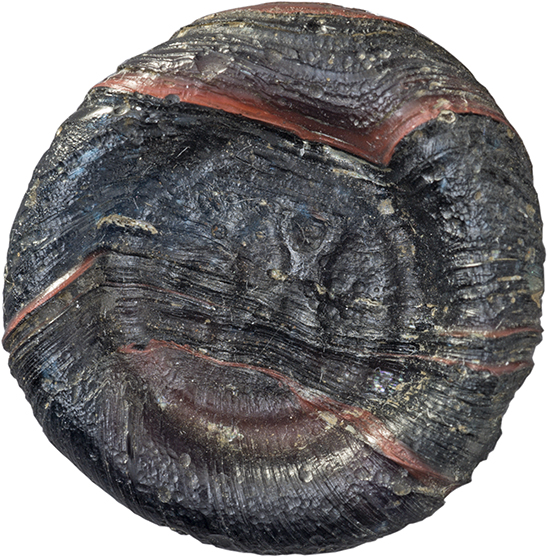
-
Copyright credit: Anatolian Weights and Measures Collection. Courtesy of Suna and İnan Kıraç Foundation Pera Museum / Bendeguz Tobias

ARCHAEOLOGICAL DESCRIPTION OF THE WEIGHT
Authority
Mint
Denomination
Material
Glass
Manufacture
Cast
Shape
Disc or similar (ellipse, etc.)
Length
2.30 cm
Width
2.30 cm
Height
0.60 cm
Metrology
| Mass (g) | Mass (grain) | Date of measurement | Reference | fragmented | cleaned | reference weight |
|---|---|---|---|---|---|---|
| 3.41 | - | - | (scientific literature) | No | No | Yes |
Iconography
| Symbol | Technique | Direction | Position | Number | Synecdoche |
|---|---|---|---|---|---|
| Wreath: line |
Wear
Corrosion
Handle
No
Suspension hole
No
Recarved mould
No
Recarved weight
No
Intentionally destroyed
No
Archaeological description
Glass weight. Disc. Colour (Farbe): rotbraun. Iconography: No cross. Wreath: line.
CPA III/2: Last third of the 6th - 1st half of the 7th century AD. Eastern Mediterranean. Weight for a silver coin (double siliqua) or a gold coin (solidus/20 carat). Glass, 23 x 4-6 mm; 3.40 g. Inv. no. PMA 482. Acquired in 2005.
Description: Black with brownish red streaks coloured, opaque round weight with a central impression. Within a circle, the retrograde block monogram is composed of the letters ΔΛ and likely an A in the centre, Ρ on the left and the genitive V and O at the top. If the letters are interpreted correctly, the monogram could be resolved as ΔΟΡVΛΑΙΟV. Due to the mas{ of the weight, which corresponds to a double siliqua (silver coin) or a light-weight solidus, we can narrow the dating from the reign of Justin II to Heraclius, when coins with this mass occur. Ref.: Published in Acara-Eser 2003: no. 62.
CPA III/2: Last third of the 6th - 1st half of the 7th century AD. Eastern Mediterranean. Weight for a silver coin (double siliqua) or a gold coin (solidus/20 carat). Glass, 23 x 4-6 mm; 3.40 g. Inv. no. PMA 482. Acquired in 2005.
Description: Black with brownish red streaks coloured, opaque round weight with a central impression. Within a circle, the retrograde block monogram is composed of the letters ΔΛ and likely an A in the centre, Ρ on the left and the genitive V and O at the top. If the letters are interpreted correctly, the monogram could be resolved as ΔΟΡVΛΑΙΟV. Due to the mas{ of the weight, which corresponds to a double siliqua (silver coin) or a light-weight solidus, we can narrow the dating from the reign of Justin II to Heraclius, when coins with this mass occur. Ref.: Published in Acara-Eser 2003: no. 62.
Autopsy
No
INSCRIPTION
| Language | Technique | Legend type |
|---|
Fac simile
Edition
{monogramma}
Monogram
Unknown-09
ARCHAEOLOGICAL CONTEXT
Findspot (region)
Findspot (site)
context
CIRCUMSTANCES OF ACQUISITION
Region
City
Date of first acquisition
circumstances
DATING OF THE WEIGHT
Curatorial Section
LATE ROMAN AND BYZANTINE
Time frame
Comments on Chronology
COLLECTION HISTORY
Collection
| Name | Date of acquisition | Inventory number |
|---|---|---|
| Pera Museum (Istanbul) | None | PMA 482 |
Bibliography
| Reference | Page/Column | Reference (number) | Plate / Figure | Comment |
|---|---|---|---|---|
| Kürkman 2003 | 219 | 62 | fig. 62 | None |
| CPAI III/2 | None | 725 | pl. 194 | None |
VARIA